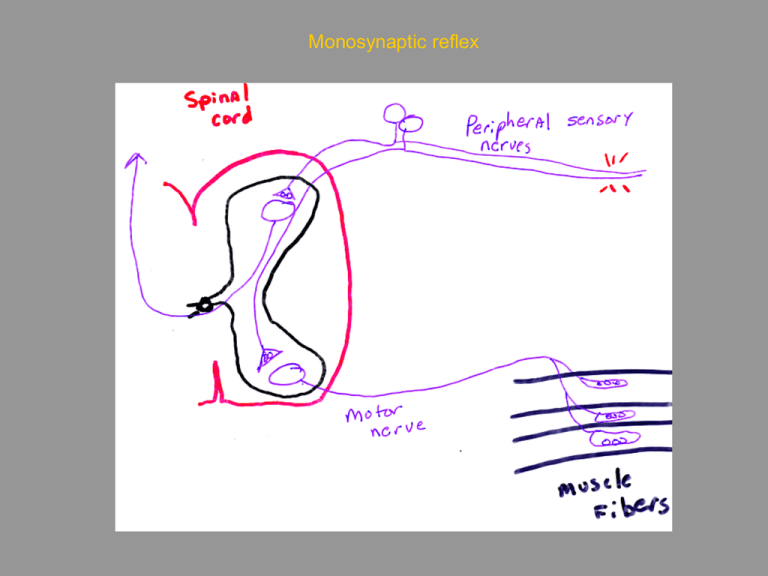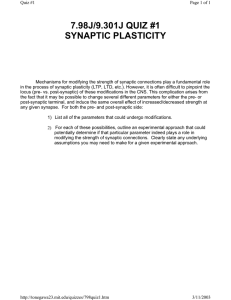Monosynaptic reflex
advertisement

Monosynaptic reflex Physiology G6001 Nerve and Synapse Classical elements of synaptic transmission: Neuromuscular junction Transmitter release Synaptic currents Synaptic potentials Nerve-nerve synapses Synaptic integration Summation Facilitation Amy MacDermott, Department of Physiology and Cellular Biophysics and the Center for Neurobiology and Behavior phone 305-3889 email abm1@columbia.edu Schematic of the NMJ The Neuromuscular Junction Physiology G6001 Nerve and Synapse Classical elements of synaptic transmission: Neuromuscular junction Transmitter release Synaptic currents Synaptic potentials Nerve-nerve synapses Synaptic integration Summation Facilitation Exocytosis and transmitter release at the nerve terminal Protein machinery for vesicle release Rizo and Sudhof Nature Reviews Neuroscience 3; 641-653 (2002); Key elements of transmitter release Recording from the neuromuscular junction (NMJ). Spontaneous release of a vesicle of Ach causes a miniature endplate potential or MEPP Evoked release following stimulation of the motor neuron causes an endplate potential or EPP Presynaptic calcium channels at the neuromuscular junction (NMJ) Pre and postsynaptic changes in membrane potential during transmitter release Recording from the neuromuscular junction (NMJ). Spontaneous release of a vesicle of Ach causes a miniature endplate potential or MEPP Evoked release following stimulation of the motor neuron causes an endplate potential or EPP The quantal nature of transmitter release. Decrease the amplitude of evoked release by recording in low Ca2+ bath. Physiology G6001 Nerve and Synapse Classical elements of synaptic transmission: Neuromuscular junction Transmitter release Synaptic currents Synaptic potentials Nerve-nerve synapses Synaptic integration Summation Facilitation NMJ – an inward current drives the change in membrane potential Membrane potential and driving force– brief review Vm= (RT/F) ln [K]o/[K]i Vm= (RT/F) ln Na]o/[Na]i Reversal potential ____________ IEPSP = gEPSP x (Vm-EEPSP) Membrane time constant – a review Synaptic potential is not actively propagated ACh binds to the nicotinic ACh receptor, causing it to gate open. The channel is permeable to both Na+ and K+. The end-plate potential causes voltage gated Na+ channels to open and an action potential to fire. An EPP in normal muscle is super-threshold for firing action potential Physiology G6001 Nerve and Synapse Classical elements of synaptic transmission: Neuromuscular junction Transmitter release Synaptic currents Synaptic potentials Nerve-nerve synapses Synaptic integration Summation Facilitation Heuser and Reese – two synapses in the cerebellum Classes of neurotransmitter receptors + - OUT ++ +++ + ++++++ +++++++++ +++++ -------- - -------- ------------ ------a b IN IONOTROPIC g METABOTROPIC Excitatory synaptic transmission is mediate by glutamate receptors Na+, Ca2 Na+,(Ca2+?) + OUT a IN * K+ NMDA receptors (NMDARs) b g K+ AMPA receptors Kainate metabotropic receptors Glu receptors Current-voltage relationship for synaptic currents mediated by AMPA and NMDA receptors Inhibitory synaptic transmission is mediated by GABA and glycine receptors Physiology G6001 Nerve and Synapse Classical elements of synaptic transmission: Neuromuscular junction Transmitter release Synaptic currents Synaptic potentials Nerve-nerve synapses Synaptic integration Summation Facilitation Membrane time constant – a review What determines the time course of the synaptic potential? Temporal summation depends on the passive membrane properties of the neuron or muscle Tau or t = C x R Summation is postsynaptic while facilitation is usually presynaptic Summation of EPSP and IPSP The trigger zone The synaptic potential is not actively propagated. The rate of decay with distance is exponential: DV(x) = DV0 e-x/l and l ~ (rm/ra) Different synaptic configurations including axo-somatic, axodendritic and axo-axonic Implications of synapse location Length constant l ~ Rm/Ra Temporal and spatial summation: importance of time constant t and length constant l Three forms of modulation of synaptic transmission mediated by metabotropic receptors Berne and Levy – chapter 4 or Kandel, Schwartz, and Jessell – chapters 11 and 12 or Kandel, Schwartz, and Jessell – chapters 10-15 Recording from the neuromuscular junction (NMJ). Spontaneous release of a vesicle of Ach causes a miniature endplate potential or MEPP Evoked release following stimulation of the motor neuron causes an endplate potential or EPP The reversal potential is determined by the concentrations of ions flowing through the synaptic channel.



